Research & Development
Challenges of sensing technology usable in extreme environments
Research and development of sensors using phase-shift optical interferometry
 Published: September 18, 2020
Published: September 18, 2020
Beginning from basic developments
based on unprecedented ideas
In 2008, we began to search for the development of new and unprecedented technology to realize earthquake observations under extreme conditions. We focused on optical sensors using optical fibers with the aim of developing a seismometer without electronic circuits or a power supply to the sensor. However, it was difficult to obtain a long-term stable output with optical interferometry available at the time, and the seismometer was considered unsuitable for field use under severe environmental conditions.
Therefore, we began the basic development of a method to measure the level of interference and level of input light that fluctuates owing to vibrations during the measurement using pulse waves. In 2011, we devised a method to measure distances fluctuating beyond a half-wavelength of light by changing the phase in a part of the optical pulse wave and developed an optical sensor system. At the Japan Society of Applied Physics, the Lightwave Sensing Technology Professional Group, held at the end of 2012, we presented, for the first time, a new and original technology called “phase shifting optical interferometry.” Then, we began to search for a joint research partner to verify the practical application of this technology.
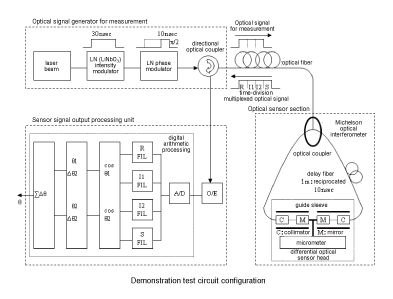
Connecting to social issues (1)Cooperation with JOGMEC’s Technological Solution Project
At that time, Japan Oil, Gas and Metals National Corporation (JOGMEC) was seeking a project that provided solutions to technological issues faced by oil-producing countries using unprecedented domestic technology.
An optical sensor system uses electricity for its optical transmitter and receiver but not for the optical fiber and sensor mounted on the tip. It meets the needs of the oil exploration industry in that it requires less maintenance (no need for battery replacements), particularly in harsh environments (deserts, deep seas, high temperatures, and pressures), and has a high-frequency band and high sensitivity. Hence, this project was selected for Phase 1 of the Technological Solution Project. Phase 1 lasted for about two years; from FY 2014 to FY 2015. Within that period, we built a prototype, conducted test field observations and geophysical surveys, and showed data comparable to those of sensors normally used in geophysical surveys. Based on these results, we proceeded to Phase 2 in FY 2016–2017 and conducted observations for several months in observation wells at the National Oil Reserve, Kikuma. In FY 2018, with funding from JOGMEC, verification of improvement was conducted as a feasibility study.*Selected projects are available on the JOGMEC website.
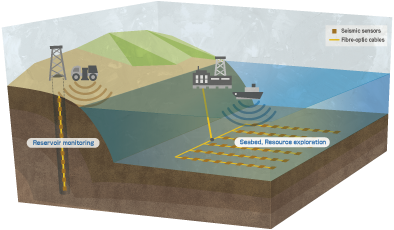
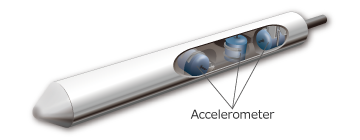 Enlarged view of the sensor unit
Enlarged view of the sensor unit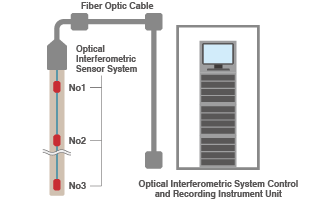 System configuration
System configuration
Connecting to social issues (2)Collaboration with the Ministry of Education, Culture, Sports, Science and Technology (MEXT)
“Comprehensive Project for Next Generation Volcano Research and Human Resource Development”
In 2016, the year after Phase 1 of the JOGMEC Technology Solution Project was completed, the optical sensor system was also selected as Project E for MEXT’s Next Generation Volcano Research and Human Resource Development Project (Volcano PJ). With the approval and cooperation of JOGMEC, we and Dr. Tsutsui of Akita University, who was appointed as the project manager, began application experiments for volcano observation. We conducted observations at the newly constructed Sakurajima–Komen tunnel with the cooperation of Dr. Iguchi of the Kyoto University. Dr. Tsutsui reported the subsurface structure of Sakurajima using data from an optical sensor system acquired during the Sakurajima tectonic survey. The evaluation of this project led to the adoption of Project B2-2, which will continue until FY 2027.
In the B2-2 research project, long-term observations were conducted at Mt. Asama in FY 2017. Subsequently, in FY 2018, to address the issues raised by the MEXT evaluation meeting, we created a sensor with a natural frequency of less than 30 Hz. In FY 2019, at the Sakurajima Haruta mountain observatory, we conducted continuous observations with Professor Nakamichi of Kyoto University for about half a year, including the period of frequent thunderstorms. As for lightning resistance performance, we anticipate the analysis report in this fiscal year.* The volcano project report is available on the website of the Ministry of Education, Culture, Sports, Science and Technology.
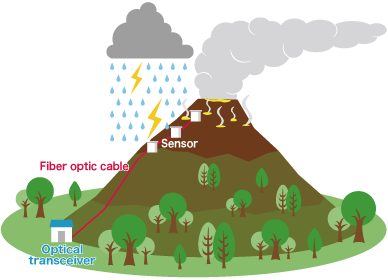
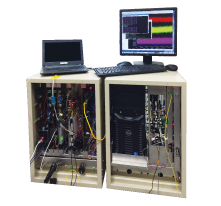 Optical transceiver
Optical transceiver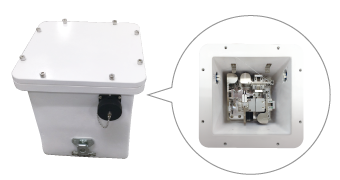 Three-component sensor
Three-component sensor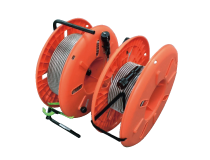 Fiber optic cable
Fiber optic cable
Meeting the challenges and pushing through new methods
Accurate seismic measurements have been achieved; however, many challenges lie ahead. The sensitivity of optical fibers is challenging. Existing optical fiber sensors (such as thermometers and strain gauges) utilize the properties of optical fibers that are sensitive to temperature and strain. However, because optical fibers are used as laser beam transmission lines, external influences on optical fibers must be extensively removed, and research to further reduce noise in the low-frequency range is being conducted.
To realize stable and highly accurate measurements, steady efforts will be made to gradually solve each problem while developing the sensor housing and fiber coating.
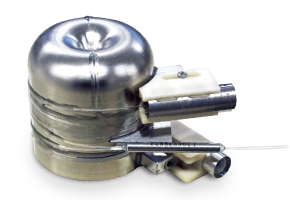
Toward the realization of high-precision measurement
in various extreme environments worldwide
With the cooperation of Tokyo Power Technology Corporation, an optical sensor system was installed at the Fukushima Daiichi Nuclear Power Plant observation well in June 2019. Although there was a missing measurement, we quickly corrected the problem and recorded continuous observations over a year. We continue to improve the system to overcome the obvious problems in the data and to make the measurement system highly accurate and stable for a long period of time.
In the future, the system will not be used for existing seismic observation networks but will be deployed to worldwide locations that are currently unobserved or difficult to observe.
Research results
Conference Presentations and Papers
- Paper“Real-Time Displacement Measurement System using Phase-Shifted Optical Pulse Interferometry: Application to a Seismic Observation System,”Japanese Journal of Applied Physics, 55, 022701, 2016.
- Paper“Principle Verification and Potential Applications of Vibration Sensors using Optical Interferometry,”Transactions of the Society of Instrument and Control Engineers, Vol. 54, No. 1, 1/6, 2018.
- Paper“Feasibility Study on a Multi-Channeled Seismometer System with Phase-Shifted Optical Interferometry for Volcanological Observations,”Journal of Disaster Research, Vol. 14, 592–603, 2019.
- Paper“Observation of Vibration Characteristics of a Cylindrical Water Tank using an Optical Pulse Interferometry Seismometer,” Japan Society of Conservation Science, Vol. 20, No. 1, 101–108, 2021.
- Bulletin & Report“A Feasibility Study on Volcanological Application of Phase-Shifted Optical Pulse Interferometry,” Chikyu Monthly, Special Issue, 2018.
- Abstract“Development of an Optical Sensor Based on Homodyne Interference Principle with an Operating Range Beyond a Half Wavelength,”Proceedings of the 50th Meeting of Lightwave Sensing Technology, LST50-4, 2012.
- Abstract“Noise Observation of Ground Motions by Phase-Shifted Optical Pulse Interferometry” (in Japanese)Proceedings of the 57th Meeting on Lightwave Sensing Technology, LST57-4, 2016.
- Abstract“Development of MEMS Vibrating Sensor with Phase-Shifted Optical Pulse Interferometry,”EDTM (Electron Devices Technology and Manufacturing Conference), 2017.
- Abstract“A Feasibility Study on Volcanological Application of Phase-shifted Optical Pulse Interferometry Vibration Observation System,”Volcanological Society of Japan 2017 Fall Meeting, A3-11.
- Abstract“Observation of Asama Volcano by Phase-Shifted Optical Interferometry Vibration Observation System” (in Japanese),Volcanological Society of Japan 2018 Fall Meeting, B3-8.
- Abstract“Performance Evaluation of Observation System Using Phase-Shifted Optical Interferometry” (in Japanese),JpGU-AGU Joint Meeting, STT51-03, 2020.
- Abstract“Observation of Sakurajima Volcano by New Phase-Shifted Optical Interferometry Vibration Observation System,”Volcanological Society of Japan 2021 Fall Meeting, A1-02.
Commercialization/practical application

Seismic monitoring system for harsh environment
(No semiconductor devices in sensors)Optical sensor seismic monitoring system by phase-shifted optical interferometryFind out more